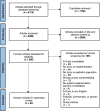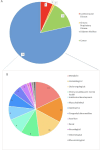Implementation factors of non-communicable disease policies and programmes for children and youth in low-income and middle-income countries: a systematic review
- PMID: 38830723
- PMCID: PMC11149138
- DOI: 10.1136/bmjpo-2024-002556
Implementation factors of non-communicable disease policies and programmes for children and youth in low-income and middle-income countries: a systematic review
Abstract
Introduction: Despite declared life-course principles in non-communicable disease (NCD) prevention and management, worldwide focus has been on older rather than younger populations. However, the burden from childhood NCDs has mounted; particularly in low-income and middle-income countries (LMICs). There is limited knowledge regarding the implementation of paediatric NCD policies and programmes in LMICs, despite their disproportionate burden of morbidity and mortality. We aimed to understand the barriers to and facilitators of paediatric NCD policy and programme implementation in LMICs.
Methods: We systematically searched medical databases, Web of Science and WHOLIS for studies on paediatric NCD policy and programme implementation in LMICs. Screening and quality assessment were performed independently by researchers, using consensus to resolve differences. Data extraction was conducted within the WHO health system building-blocks framework. Narrative thematic synthesis was conducted.
Results: 93 studies (1992-2020) were included, spanning 86 LMICs. Most were of moderate or high quality. 78% reported on paediatric NCDs outside the four major NCD categories contributing to the adult burden. Across the framework, more barriers than facilitators were identified. The most prevalently reported factors were related to health service delivery, with system fragmentation impeding the continuity of age-specific NCD care. A significant facilitator was intersectoral collaborations between health and education actors to deliver care in trusted community settings. Non-health factors were also important to paediatric NCD policies and programmes, such as community stakeholders, sociocultural support to caregivers and school disruptions.
Conclusions: Multiple barriers prevent the optimal implementation of paediatric NCD policies and programmes in LMIC health systems. The low sociopolitical visibility of paediatric NCDs limits their prioritisation, resulting in fragmented service delivery and constraining the integration of programmes across key sectors impacting children, including health, education and social services. Implementation research is needed to understand specific contextual solutions to improve access to paediatric NCD services in diverse LMIC settings.
Keywords: adolescent health; child health; developing countries; health services research; noncommunicable diseases.
© Author(s) (or their employer(s)) 2024. Re-use permitted under CC BY-NC. No commercial re-use. See rights and permissions. Published by BMJ.
Conflict of interest statement
Competing interests: None declared.
Figures






Similar articles
-
Integrating tuberculosis and noncommunicable diseases care in low- and middle-income countries (LMICs): A systematic review.PLoS Med. 2022 Jan 18;19(1):e1003899. doi: 10.1371/journal.pmed.1003899. eCollection 2022 Jan. PLoS Med. 2022. PMID: 35041654 Free PMC article.
-
An analysis of policy and funding priorities of global actors regarding noncommunicable disease in low- and middle-income countries.Global Health. 2021 Jun 29;17(1):68. doi: 10.1186/s12992-021-00713-4. Global Health. 2021. PMID: 34187499 Free PMC article.
-
Integration of non-communicable disease and HIV/AIDS management: a review of healthcare policies and plans in East Africa.BMJ Glob Health. 2021 May;6(5):e004669. doi: 10.1136/bmjgh-2020-004669. BMJ Glob Health. 2021. PMID: 33947706 Free PMC article. Review.
-
Opportunities and challenges to non-communicable disease (NCD) research and training in Pakistan: a qualitative study from Pakistan.BMJ Open. 2022 Dec 19;12(12):e066460. doi: 10.1136/bmjopen-2022-066460. BMJ Open. 2022. PMID: 36535721 Free PMC article.
-
Implementation of national policies and interventions (WHO Best Buys) for non-communicable disease prevention and control in Ghana: a mixed methods analysis.Health Res Policy Syst. 2024 Nov 15;22(1):154. doi: 10.1186/s12961-024-01242-3. Health Res Policy Syst. 2024. PMID: 39548534 Free PMC article.
References
-
- Non communicable diseases. Available: https://www.who.int/news-room/fact-sheets/detail/noncommunicable-diseases [Accessed 24 Apr 2024].
-
- NCD Child . Children & non-communicable disease: global burden report 2019. Available: https://www.ncdchild.org/2019/01/28/children-non-communicable-disease-gl... [Accessed 31 May 2023].
-
- UNICEF DATA . Non-communicable diseases. Available: https://data.unicef.org/topic/child-health/noncommunicable-diseases/ [Accessed 31 May 2023].
Publication types
MeSH terms
LinkOut - more resources
Full Text Sources
